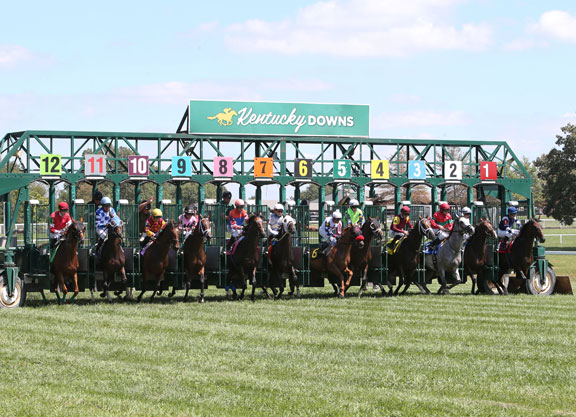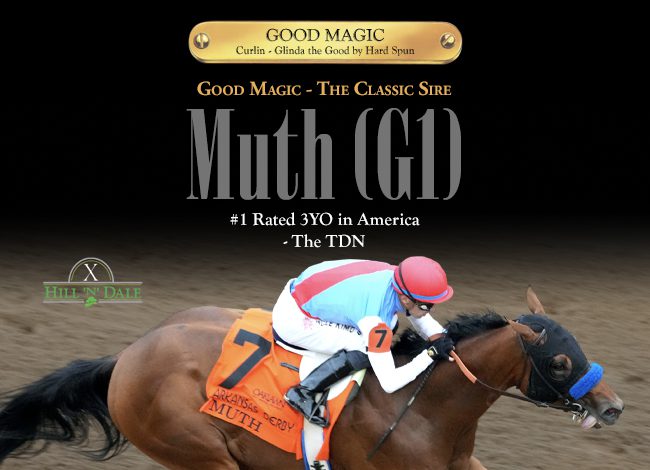By Kelsey Riley
The most savvy European horse people have long had autumn dates annually etched onto their calendars at courses like Woodbine, Arlington, Keeneland and Belmont, where sizable purses are up for the taking for those enterprising enough to travel.
As the tempo begins to climb toward those fall features, however, there is another American racecourse that has gotten first run, and it is possible you have never even heard of it.
Beginning on Sept. 7 through Sept. 16, The Runhappy Meet at Kentucky Downs-situated 2 1/2 hours southwest of Lexington on the Tennessee border-will stage its annual turf-only meet over six days offering $10 million in purses on the grass with the maximum payout available to Kentucky-breds.
There are 16 stakes races slated, five of which are graded. The richest opportunity is the $1-million GIII Calumet Farm Kentucky Turf Cup going a mile and a half for 3-year-olds and older-Leopardstown's G3 Kilternan S. run on the same day over the same distance is worth approximately $112,000, and the next day's G2 Prix Foy has a purse of $146,000. The Runhappy Meet at Kentucky Downs will host stakes over a mile and six furlongs for 3-year-olds and older, the Listed Tourist Mile for $750,000 and the GIII Runhappy Turf Sprint worth $700,000 and part of the Breeders' Cup Challenge Series-there are Group 1s happening during the same week in Europe worth less money.
During a time of year in Europe where restricted 3-year-old opportunities at the pattern level have largely disappeared, Kentucky Downs has four stakes for that generation highlighted by the Listed Gun Runner Dueling Grounds Derby and the Exacta Systems Dueling Grounds Oaks over 2100 metres and worth $750,000 and $500,000, respectively. There are four black-type opportunities for 2-year-olds both colts and fillies over 6 1/2 furlongs and a mile with purses from $400,000 to $500,000, while the eight Group 2 and 3 2-year-old races during the same week in Britain, Ireland and France range from $80,000 to $170,000. Even maiden races at the meet are worth $90,000 and allowance races up to $100,000. Purses of black-type races at Kentucky Downs include a 40% to 50% contribution from the Kentucky Thoroughbred Development Fund and those extra funds are restricted to horses bred in the state. Therefore, bringing a Kentucky-bred back to its home turf is the most lucrative option.
Both the purses and the KTDF are fueled largely by Kentucky Downs's on-site casino, which features historical horse racing games where players wager on real races that have already been run but are randomly selected from a library and have had the horses' names removed.
“Our purses are the largest daily purses in the world except for Japan,” said Ted Nicholson, Kentucky Downs's senior vice president and general manager. “The purse structure is generated primarily through historical horse racing, which has become very popular in Kentucky. In a normal year we would generate approximately $20 million in purse money that has to be distributed. Last year our purse structure here was about $11.5 million, and we had sent $5.2 million to Ellis Park. So between the two meets last year we were close to $17 million and we had projected to be just shy of $20 million for this year before COVID kind of put the stop to everybody's fun.”
Indeed, COVID-19 threw a bit of a wrench in the track's upward momentum with its casino closed for three months between March and June, but that proved to be a minor blip on the radar. Nicholson reported business to be strong since the casino's patrons were welcomed back on June 10.
The ever-shrinking world of bloodstock trade means that Kentucky-breds are sprinkled across the globe, and Nicholson explained why the Kentucky Downs meeting is a lucrative opportunity for European horsemen to bring their Kentucky-breds back to their place of birth.
“A small percentage of each wager on our gaming floor goes toward the Kentucky Thoroughbred Development Fund,” he said. “Ultimately, our purses are eye-opening because of the KTDF. We have a race on Sept. 10 called the Gun Runner Dueling Grounds Derby and it's for 3-year-olds going 1 5/16 miles [2100 metres] and the purse is $750,000. Half of that, $375,000, is from the KTDF. So if you came here with a [non Kentucky-bred] and won that race, you're running for $375,000. But if you're a Kentucky-bred you're running for $750,000. So it's dramatic. Most of the stakes are about a 50% enhancement which comes from the KTDF. If you have a Kentucky-bred and you're not racing here, you need to scratch your head a little bit.”
While coronavirus restrictions will make travel details from Europe to Kentucky in 2020 a challenge, the meeting traditionally holds a slot on the calendar where it could be used as a prep some Woodbine's high-profile turf cards or the Breeders' Cup when travel does become commonplace again.
“The way our meet is positioned seven weeks in front of the Breeders' Cup does set us up pretty well to get horses here, have them run for a sizeable purse and if they run well they're going to set themselves up well for a nice run in the Breeders' Cup,” Nicholson said.
And while the large prize pots are a nice perk for the humans, the horses will enjoy a course something akin to what they have at home. Kentucky Downs is not a traditional American oval, but rather a wide, sweeping and undulating course.
“In most spots the course is over 120-feet wide,” Nicholson said. “When you look at it from the announcer's booth you can see the course elevating up the backstretch and then as they go around the far turn the course does dip down; it's not dramatic but it is noticeable. There is a little jog to the right as they're about to go into the far turn. It's a very unique course. It's 1 5/16 miles [2100 metres] around. Most of the races are one-turn because we can run up a mile and 70 yards going one-turn. When we do run longer races they're typically a mile and a half or 1 5/16 miles. The jockeys love the course. Our track superintendent, Butch Lehr, is very well known in the United States and for about 30 years was the track superintendent at Churchill Downs. So he knows his way around a blade of grass.”
During a time when it is becoming increasingly necessary to shop around for the best purses on offer, Kentucky Downs is a bright beacon for trainers with Kentucky-breds in their yards. Already a hidden gem among the American racetrack community, it is not likely to fly under the radar on the global stage much longer.
Not a subscriber? Click here to sign up for the daily PDF or alerts.






